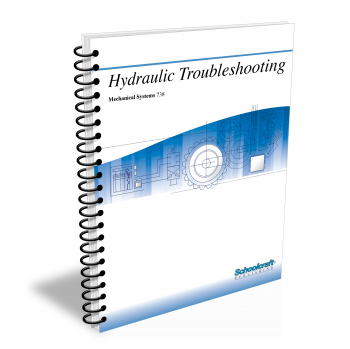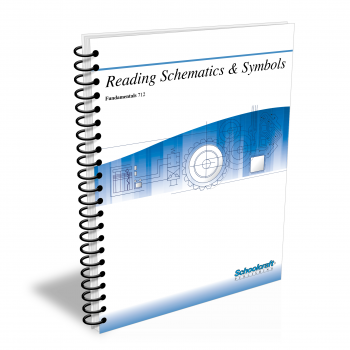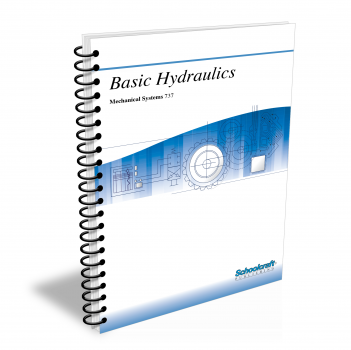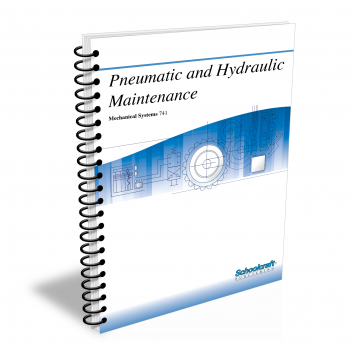Hydraulic Troubleshooting

Course Number: 738
The Hydraulic Troubleshooting textbook is the second of a pair on hydraulics, following the 737 textbook on Basic Hydraulics. It deals with the system as a whole, including the use of drawings and diagrams to understand the system, the installation of equipment, maintenance, and troubleshooting. In addition to specific repairs, the textbook deals with planned maintenance of the system to achieve maximum performance.
Does your curriculum require additional topics not included in this textbook? Build a customized version of the Hydraulic Troubleshooting textbook below.
This textbook has been recently updated
to include topics lists, objectives, & key terms for every chapter.
Recommended Contact Hours – 15
Preview a Chapter
Available Supporting Material
- Table of Contents
- Exam Copies
- Suggested Titles
Table of Contents
Chapter 1: Tracing Hydraulic Systems
Topics: System components; Hydraulic fluids; Tracing the system; Schematics; Cutaway drawings; Mechanical setup
Learning Objectives:
- Name the six basic elements of a hydraulic system.
- Explain the functions of hydraulic pumps, actuators, control valves, conductors and connectors, hydraulic fluid, and fluid storage and conditioning equipment.
- Describe how to trace a system.
Chapter 2: Hydraulic Diagrams
Topics: Definition, kinds, and characteristics of schematics; Lines; Symbols; Flow patterns; Tracing a circuit; Sequence valve circuit
Learning Objectives:
- Name three basic types of hydraulic diagrams, and explain the purposes of each.
- Describe how a valve symbol is constructed.
- List the steps to follow when reading a schematic diagram.
- Identify common hydraulic symbols.
Chapter 3: Installing Hydraulic Components
Topics: Safety; Cleanliness; Pump, drive, control valves, and mechanical valve installations; Pump start-up; Valve port identification
Learning Objectives:
- Explain the importance of cleanliness in hydraulic installations.
- Describe possible consequences of neglecting safety precautions.
- Explain how motor and pump shafts are aligned before coupling.
- Explain the correct method for checking direction of pump rotation.
- List several useful hints for solenoid valve installation.
Chapter 4: Installing Piping and Tubing
Topics: General installation procedures; Tube flaring; Checking the flare; Tube bending and assembly; Hose, seal, reservoir, filter, heat exchanger, and actuator installation
Learning Objectives:
- Explain how pipe sizes are specified.
- Name the common types of pipe joints.
- List six important rules for good piping installation.
- Describe the advantages of hydraulic tubing over pipes.
- Describe the correct methods for bending and flaring tubing.
- List the key points for correctly installing hydraulic hoses, seals, reservoirs, filters, and actuators.
Chapter 5: Selecting Hydraulic Fluids
Topics: Viscosity; Resistance to chemical and physical changes; Low-temperature properties; Demulsibility; Antirust properties; Compatibility
Learning Objectives:
- List ten important properties of hydraulic fluids.
- Explain the difference between hydrodynamic and boundary lubrication.
- Explain what a fluid's viscosity index means.
- Define demulsibility and emulsibility.
- Describe how to read a viscosity-temperature chart.
- List the proper procedures for installing hydraulic fluid.
Chapter 6: Maintaining Hydraulic Systems
Topics: Inspections; Maintenance requirements; Fluid level; External leaks; Operating pressure; Fluid quality; Filter maintenance; Reconditioning
Learning Objectives:
- List the major categories of hydraulic system maintenance.
- Name and describe the six essential items in a maintenance file.
- List the steps involved in reconditioning a hydraulic component.
- Explain how to set up a maintenance plan for a typical hydraulic system.
Chapter 7: System Troubleshooting
Topics: Diagnosis and symptoms; Evaluating machine history; Determining the cause; Providing the solution; Tools and gauges; Troubleshooting charts
Learning Objectives:
- Describe the troubleshooting process.
- Explain how to evaluate recent maintenance history.
- List typical symptoms of common hydraulic system problems.
- Explain how to determine the cause of and provide a solution to a problem.
- Explain how a portable tester works.
- Describe how to keep and use troubleshooting charts.
Chapter 8: Valve Troubleshooting
Topics: Valve problems and test procedures; Disassembly, cleaning, and inspection; Repair and replacement; Solenoid problems; Reassembly and testing
Learning Objectives:
- Name five common valve problems and explain the sequence of steps to be followed in troubleshooting them.
- Describe the proper procedures for valve disassembly, cleaning, and inspection.
- Explain how to determine whether to repair or replace a malfunctioning valve.
- Describe the reasons for hydraulic "wire drawing."
- List the reasons for electrical and mechanical failures of solenoid valves.
- Explain the procedures for reassembling, reinstalling, and testing valves.
Chapter 9: Cylinder Troubleshooting
Topics: Cylinder descriptions; Troubleshooting procedures; Cylinder testing, repair, and installation; Shock absorbers
Learning Objectives:
- Name the most common types of hydraulic cylinders and identify their major parts.
- List the symptoms of internal and external cylinder misalignment.
- Explain what to do if you find internal leakage in a cylinder.
- Name the cylinder components most frequently replaced.
- Explain the purpose of a piston rod boot.
- Describe the symptoms of shock absorber failure.
Chapter 10: Pump and Motor Troubleshooting
Topics: Gear and vane pump problems; Vane motors; Axial- and radial-piston pump problems; Pump and motor repair; Pump maintenance checks
Learning Objectives:
- List the proper procedures for troubleshooting pumps and motors.
- Name some common causes of pump failure.
- Describe typical causes of cavitation.
- Discuss the major sources of problems in gear pumps and vane pumps.
- Describe the effects of contaminants in axial-piston and radial-piston pumps.
- Explain the differences between a vane motor and a vane pump.
Request Exam Copies
Exam Copies
Ready to see a copy of our textbooks? After selecting which textbooks you’d like to review for your course, you can submit your request by either logging in or creating an account so we know where to ship your exam copies. A representative from Schoolcraft will contact you to confirm and finish processing your request.
Exam copies are always free and yours to keep.
Selected Exam Copies
none selected
* Maximum of five copies can be ordered


